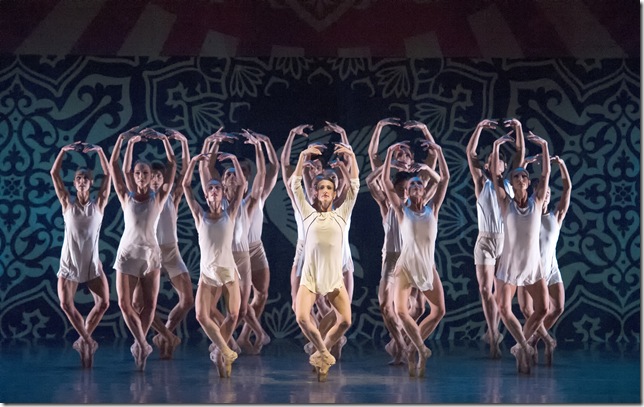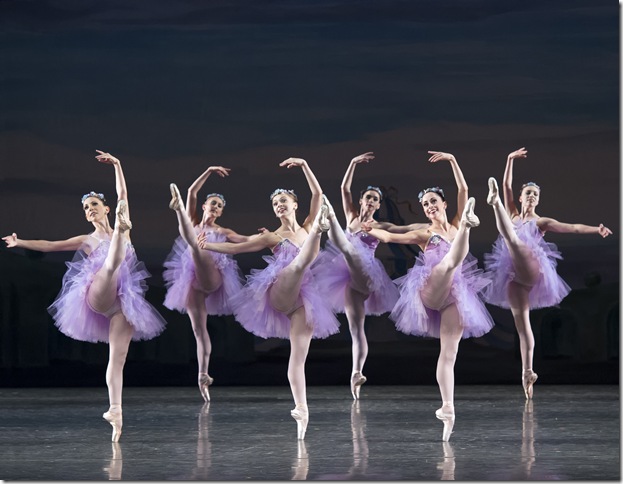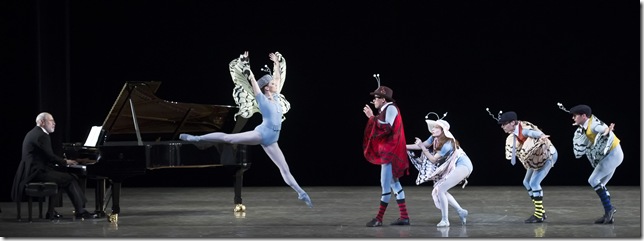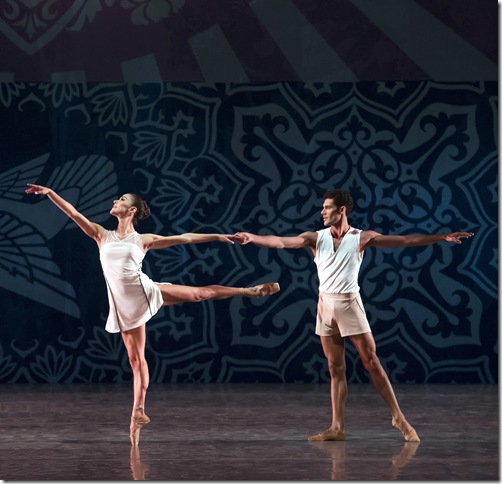By Tara Mitton Catao
Miami City Ballet opened its Program IV, the final one of the season, this past weekend at the Kravis Center, and it was a splendid showcase for the company.
The dancers sparkled with vitality and charm as they zipped through the demands of each of the three works presented. Showing off all the company’s attributes, the program offered just the right mix of old and new.
Sticking to the recipe of always programming a work by George Balanchine as an opener, Saturday night’s show also included a light-hearted company premiere by Jerome Robbins and a substantial world premiere by the young and talented Justin Peck. The evening was called Points of Departure, because each of the choreographers is known for taking his own distinctive choreographic path.
The first offering, which set the tone for the high-level dancing seen throughout the evening, was Balanchine’s Raymonda Variations, choreographed in 1961. The nine variations were culled from the wonderful music that Alexander Glazunov created for the incomparable ballet choreographer Marius Petipa in 1898 for his ballet Raymonda. Though Balanchine himself referred to this work as “Glazunov soup,” it was decidedly un-soup like to view.
Throughout, it was distinct — bright and clear — even though the large, old-style painted backdrop was initially distracting and clouded the view of the beautiful formations and syncopated steps. Balanchine’s plotless dances (which are usually done without a set so that the focus shifts to highlight the movement and the beauty of the ballet vocabulary) are considered the epitome of neoclassical ballet.
The corps de ballet in Raymonda Variations was exceptionally lovely. Breathing life and musicality into the work, the dancers moved with clarity and ease while dressed in soft lilac tutus. Leigh-Ann Esty danced Variation VII with beauty and presence. The lead couple was danced by Mary Carmen Catoya and Renato Penteado.
Humor — if it connects — has the potential to trump anything. After all, we all love to laugh, and how often do we laugh at a ballet performance? Though it was dated, The Concert (or, the Perils of Everybody) choreographed by Jerome Robbins in 1956, was charmingly dated and had a sweet draw to the audience as it poked fun at being an audience member.
One can never tire of the antics of a hen-pecked husband (Carlos Miguel Guerra) smitten by a free-spirited beauty (Jennifer Carlynn Kronenberg) and hounded by his principled wife (Callie Manning) or the antics of a bespectacled ballerina (Adrienne Carter) in the corps de ballet who always seemed to find herself either in the wrong place, the wrong position or both.
A nod of the head (and a smile) needs to go to another performer — Francisco Rennó, MCB’s music adviser and company pianist — not only for his excellent musical interpretation but also for his endearing portrayal as an irritated pianist giving a concert of Chopin.
The main event was the world premiere of an exciting work by Justin Peck, the new darling of the ballet world. Aptly called Heatscape, it was a well-structured work that left a strong visual memory as it bounced and echoed off the vast backdrop that stretched boldly across the stage.
Peck is a gambler. He likes to take an array of different influences and then toss the dice to see what happens. But he is also a consummate assembler, finding connections and building bridges until he has created a symbiotic link between these elements. This process results in the creation of works that are quite different from each other.
Peck’s ingredients for Heatscape included the music of Czech composer Bohuslav Martinů, the visual art of Shepard Fairey (the popular/street artist whose work includes the 2008 “Hope” portrait of Barack Obama), the costume design of Reid & Harriet Designs and the lighting design of Brandon Stirling Baker. He then added a little of the spice and life of Miami and the main element: the strong and vibrant dancers of Miami City Ballet.
Presentation was key. The grand-scale design by Fairey had a strong impact, with a huge, omnipresent mandala that looked like a radiating sun as it loomed over the dancers. Along the bottom was a contrasting dark strip that hinted of a graffiti wall in an urban cityscape and served as another excellent visual dimension that brightly silhouetted the dancers.
Peck reiterated the design motifs in his floor patterns, often building from the inside out in concentric circles. The whole work had a luxuriousness akin to the feel of a rich fabric but at the same time, it had a trendy, young and lively mood like that of Miami, which was reinforced by the elegant and subdued, cream and beige costumes that the dancers wore.
Peck continued the contemporary feel by not highlighting the soloists in the usual ballet way. They were not permanently designated but just momentarily seen. They were fleeting in and out of the groups of 17 dancers, weaving patterns and formations that were refreshingly not gender-specific.
In the first movement, it was Renan Cerdeiro who sought out Patricia Delgado dancing together with wonderful energy and abandon, and in the third movement, Jeanette Delgado connected with Andrei Chagas and Simon Ito, all three pulling out all the stops and dancing with a dynamic physicality.
There was a changeup in the second movement, a moment of respite. Alone onstage in a new space of coolness and calm, Tricia Albertson and Kleber Rebello beautifully danced a distinctive, contained duet in which the partners stayed only lateral in movement: up, down and side-to-side.
Justin Peck was a great fit for Miami City Ballet and he has created a signature ballet for the company. This performance of Heatscape captured the beauty and the ephemeral nature of performing dance. Once it is over, it only exists in our mind as a treasured memory much, like the extraordinary sand mandalas that the Tibetan monks take countless weeks to create, only to blow away in an instance.
Miami City Ballet will perform Program IV: Points of Departure at the Adrienne Arsht Center in Miami April 10-12 (arshtcenter.org) and at the Broward Center in Fort Lauderdale April 17-19 (browardcenter.org).



